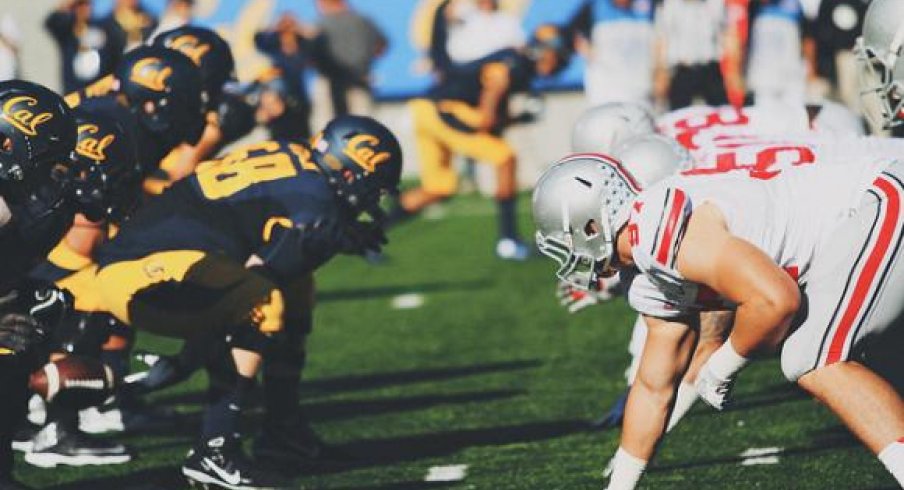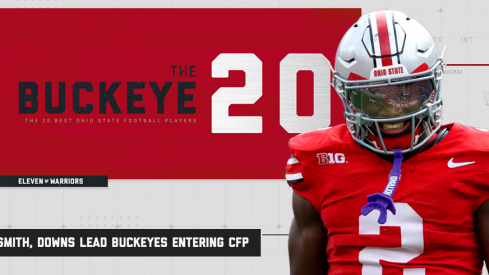When Urban Meyer became the football coach at The Ohio State University, there was a common narrative about how he would impact the defensive line; namely, that he would raise it to an SEC level of play. Everyone knew about his high-flying offense, but the lasting image from that ugly night in Glendale (too soon?) was Troy Smith being sacked six times. This perception had a basis in reality: between the 2006-2010 NFL drafts, eight of Meyer's Gator defensive linemen were selected in the NFL draft. Four were drafted in 2007.
Meyer has a knack for defensive line recruiting, and it didn't take long for him to make a splash at Ohio State. Less than a month after taking the job in Columbus Meyer landed commitments from the nation's top defensive end, Noah Spence, and four-star defensive tackle Tommy Schutt. He's continued the recruiting success along the defensive line with national talents like Joey Bosa, Jamal Marcus, Tyquan Lewis, Michael Hill and others.
The Buckeyes now have one of the most talented defensive lines in the country, and expectations for this position group are through the roof. A certain Mr. Phil Steele even named the 2014 Buckeye defensive line as the best in the nation in a season preview earlier this week.
Similarly to offensive lines, it's hard to quantify how strong a defensive line is. Sacks are a decent indicator of a pass rush, but there are other factors: how often a team blitzes, how good it's defensive backs are, and so on. Opponents' yards per carry is a decent stat, but it can be skewed by long runs.
To get a better idea about how good last season's defensive line was, I'm going to look at two stats in particular - Opponents' Good Blocking Rate (oGBR) and Sack + Hurry Percentage (S+H%).
Good Blocking Rate is explained in this piece on the offensive line (spoiler: they were really, really good). For clarification, the percentage in oGBR still indicates how often the offensive line provides "good blocking." This stat effectively isolates the offensive line-defensive line interaction on running plays and puts a percentage on how often the offense wins.
Sack + Hurry Percentage is simply the percentage of opponents' dropbacks during which the quarterback was either sacked or hurried. Hurries are an officially recorded stat, and are self-referentially defined as "when [the defender] hurries the quarterback into throwing the ball before he is ready." S+H% is not officially recorded, but I think it's a solid indicator of the defense's ability to pressure the quarterback. It is essentially the percentage of dropbacks in which the quarterback is pressured.
Knockdowns, while a nice stat, are excluded in S+H% because they don't always represent plays on which the quarterback is pressured. Sometimes a quarterback stands in the pocket and makes a strong throw, unharried by the pressure, and the pass is knocked to the ground at the line. Including only sacks and hurries makes things a bit simpler; it's hard to determine exactly how much the defensive line has on plays like this or this.
S+H% is a nice barometer for the defensive line's pass rushing ability, while oGBR gives us a measurable for the defensive line's run stopping ability. Together, I think they give us a solid indication of how last year's defensive line performed and what that means for this coming season.
For reference's sake, here are your basic stats (national rank in parentheses):
| Sacks | Sacks per game | sack yardage | Rushing yards/carry (allowed) |
|---|---|---|---|
| 42 (3) | 3.0 (5) | 292 (3) | 3.1 (7) |
Those are strong numbers. Let's see what the advanced stats have to say. As established by previous work on GBR, anything above 60% is solid blocking by the offensive line, anything above 65% is very good and anything above 70% is elite.
| Rush Attempts | Good Blocking | oGBR | Pass Attemtps | Sacks | HurrIes | S+H% |
|---|---|---|---|---|---|---|
| 422 | 260 | 61.6% | 534 | 32 | 15 | 8.80% |
Seeing the Buckeye defensive line allowing good blocking on 61.6% of rushing attempts is surprising. Stanford's offensive line had good blocking on 61.2% of rushing plays, so the fact that Ohio State's opponents had more success driving the Buckeyes off the line of scrimmage on an average play doesn't look too good. Here are the stats broken down by opponent:
| BUF | sdsu | cal | famu | wis | nw | iowa | psu | pur | ill | ind | um | MSU | CLEM | |
|---|---|---|---|---|---|---|---|---|---|---|---|---|---|---|
| oGBR | 47.1% | 54.2% | 67.6% | 47.6% | 64.0% | 55.3% | 74.1% | 75.0% | 66.7% | 59.4% | 54.3% | 62.5% | 50.0% | 81.8% |
| S+H% | 3.1% | 9.8% | 7.5% | 12.5% | 5.9% | 16.1% | 5.9% | 16.1% | 13.8% | 15.0% | 7.5% | 5.3% | 12.5% | 2.5 |
Removing the Clemson game (81.8%) from consideration would give Ohio State an oGBR of 59.9%, so even that brutal game didn't make an enormous difference over the course of the season.
Knowing what we do about GBR, a 61.6% oGBR may look weak. Nevertheless, oGBR and S+H% need to be contextualized by comparing them to some other lines from power schools.
| Ogbr | S+H% | |
|---|---|---|
| Florida State | 55.4% | 7.1% |
| South Carolina | 61.3% | 12.1% |
| Notre Dame | 60.4% | 6.7% |
Florida State was clearly a tier above the Buckeyes in terms of their defensive line's ability to stop the run, and South Carolina had an incredible pass rush. Still, Ohio State's defensive line was pretty strong against the run last year and excellent rushing the passer.
Digging a little deeper into the comparison between these teams, I found that Florida State and Notre Dame got a lot of their pressure from their linebackers (remember that sacks and hurries by non-defensive linemen were not included in S+H%). The fact that Ohio State finished 3rd nationally in sacks with the majority of heavy lifting being done by the defensive line is a good sign for this season. At the same time, it raises even more questions about the back seven's play. The back seven didn't have to play press coverage and didn't have to blitz much to generate pressure, and yet they finished 2013 like... that.
When compared to these three schools, Ohio State's 61.6% oGBR doesn't look so bad. More testing needs to be done with GBR to get a better understanding of where to draw the line between mediocre and good - somewhere between 55% and 60% - as most of the work I've done has involved good teams (note: no matter what, a 75% GBR is spectacular). From a defensive line perspective, I think 60% oGBR should be considered solid defensive line play, 55% or lower as very good and anything above 65% as poor play.
Here's another way to interpret OSU's results: when quarterbacks dropped back and had to throw the ball down the field (which wasn't often), they rarely had time to do so. That's the only plausible explanation for the high sack rate along with very poor pass defense stats. Had the Buckeyes had taken away the short passes, opposing quarterbacks rarely would have had time to beat them deep. A simple scheme change, one Chris Ash is expected to implement, could take advantage of this defensive line's strength to mask holes in the secondary.
The other main change for the defensive line this fall will be a larger rotation. Mike Vrabel didn't like to rotate defensive linemen much, and in fairness the guys he had on the field were pretty good. Defenses tend to wear down and offensive lines thrive as the game drags on, but teams actually ran the ball a bit worse against this defensive line in the fourth quarter last year.
| rush attempts | well blocked | oGBR | |
|---|---|---|---|
| 1st-3rd Quarters | 321 | 202 | 62.9% |
| 4th Quarter | 101 | 58 | 57.4% |
I think the idea that guys needed to be fresher was a bit overstated. The defensive line's endurance may be a testament to Mickey Marotti's strength and conditioning program. While the importance of rotating may have been overplayed, a deeper defensive line will be more critical this year with Noah Spence's suspension and Jamal Marcus' dismissal.
The defensive line's advanced numbers are actually stronger than I expected, and with proper scheme modifications to take advantage of the line the defense should be improved in the fall.


